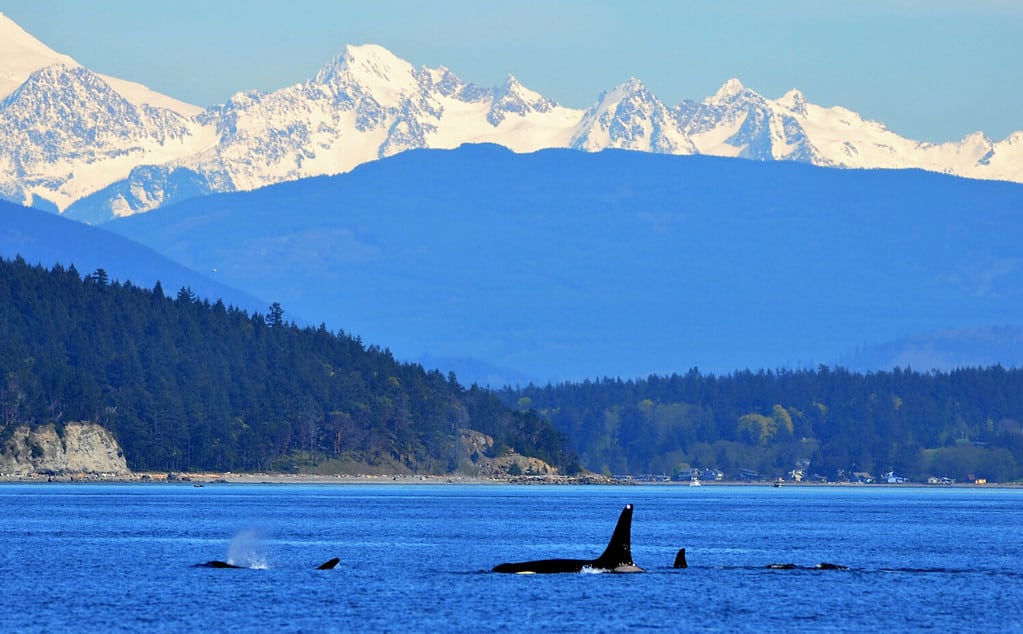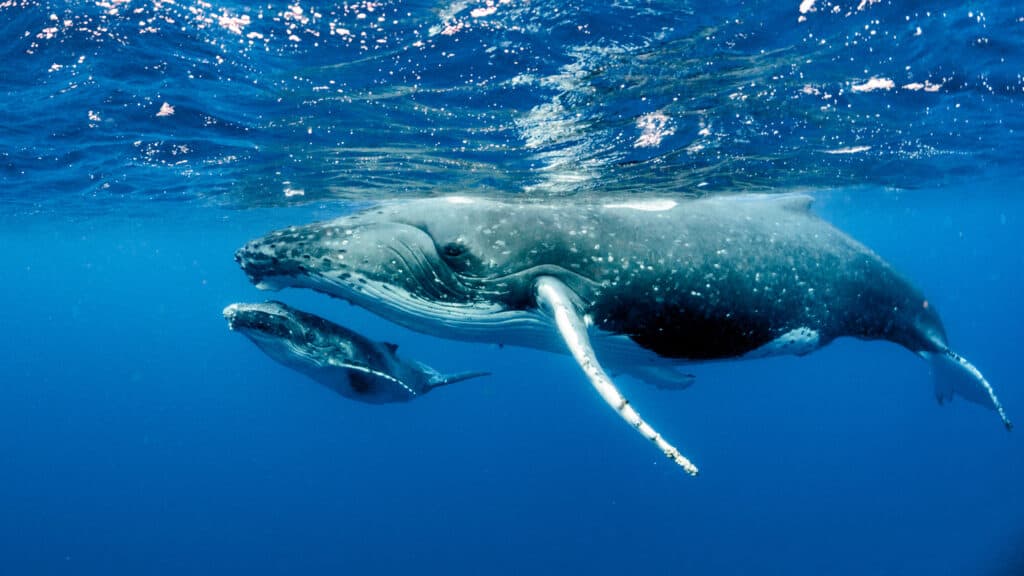Puget Sound is a breathtakingly beautiful place in the Pacific Northwest. Puget Sound is an estuary that is connected to the Pacific Ocean. It is part of the Salish Sea, which includes Puget Sound, the Strait of Juan de Fuca, the Strait of Georgia, Deception Pass, Swinomish Channel, and numerous smaller waterways that connect. This area is adjacent to Washington state and British Columbia in Canada.
This area is home to many animals both on land and in the water. Because it connects to the Pacific Ocean, even large marine mammals come into the sound often. They can be seen from land or from one of the many whale-watching tours offered for residents and tourists. If you want to see whales in person, Puget Sound is a great place to go.
All whales are protected by the Marine Mammal Protection Act. The National Oceanic and Atmospheric Administration, NOAA, oversees the policies and regulations that protect whales. These generally include leaving all whale species alone, whether they are endangered or not. This ensures that the populations are able to survive and thrive in the wild. It also regulates where and how loud human-generated noise can be. Many whales use echolocation to get around and find food. Excessive noise from boats can interfere with this process.
One of the best ways to see whales in Puget Sound is to go on a guided whale-watching tour. Not only do these experienced guides know all of the regulations, but they can also teach you a lot about the whales you see. Many whales in Puget Sound are considered residents and are recognizable by people who see them often. A great guide will point out individual whales and tell you their story.

©GeorgeColePhoto/Shutterstock.com
#1 Orcas
These whales are popular in Puget Sound, not only for their startling appearance but also for their place in local history. Orcas are also very fun to watch on a whale-watching tour. There are three pods of Orcas that live in Puget Sound. They are called the J, K, and L pods. Local and national organizations, such as The Nature Conservancy, take steps to protect these whales and their habitat.
Orcas, also called Killer Whales, usually eat fish and marine mammals. There are three distinct types, although they all belong to the same species. They are described by their behavior. Transient killer whales move from place to place. These whales venture as far north as Alaska and as far south as California. They are commonly seen in the Salish Sea. Offshore killer whales live (you guessed it) offshore and eat larger marine life, such as sharks.
The killer whales that live in Puget Sound are resident killer whales. They are called the Southern Residents because they live in the southern part of their range. The Northern Resident population lives near British Columbia. Resident killer whales only eat chinook salmon. Changes in the numbers of available salmon can have immediate impacts on the killer whale population and their health.

©JSim2018/Shutterstock.com
#2 Humpback Whales
These large whales migrate through the Puget Sound as they travel. There are multiple populations that all make their way through the area at various times of the year. There are three main populations that can be seen off the coast of Washington state. The Central America Distinct Population Segment (DPS) is considered endangered by the National Marine Fisheries Service due to the low numbers of whales remaining in the wild. The Mexico DPS is listed as Threatened. The third population is the Hawaii DPS, which is no longer considered endangered due to conservation efforts.
Humpback whales are very large and can get up to 60 feet long. They spend time in the water around Puget Sound feeding. These whales use baleen to trap large amounts of seawater then filter out what they don’t eat and leave the rest behind in their mouths.
If you’ve ever wanted to see a majestic whale breach, watching for humpback whales should be at the top of your list. These giants of the ocean can jump as high as 40 feet out of the water. Of course, they land with an equally giant splash, often to the delight of anyone observing. It’s thought that they do this to communicate with potential mates or even just for fun.

©Imagine Earth Photography/Shutterstock.com
#3 Gray Whales
There aren’t a lot of gray whales in Puget Sound but the population that stops by during their annual migration can be counted on to always pay Puget Sound a visit. These whales, also called the “Sounders,” are part of the Eastern North Pacific gray whale population. They spend part of the year off Baja in warm waters. During their northern migration, the Sounders break off from the rest of the migrating whales and go into Puget Sound.
What makes Puget Sound such a must-visit spot for the 12-15 whales that stop by? They spend a couple of months feeding on shrimp so we have to imagine that something about the food can’t be missed. They eat ghost shrimp when they feed. In fact, they eat so many ghost shrimp that they leave depressions in the ocean floor’s sediment when they forage as can be seen in images taken by satellites.
One of the fun things about watching for the Sounders is how easy it is to identify the regulars that visit Puget Sound. The whales are given an identification number by the Cascadia Research Collective, the organization which tracks and studies their movements. They are also given a fun name to describe their look or personality, such as Patch (CRC ID #49) who is named for the telltale white patch on his back.

©Jan-Dirk Hansen/Shutterstock.com
#4 Minke Whales
Most northern minke whales are migratory but there is a resident population around Puget Sound that stays in the area year-round. More sightings are reported in the summer months, however, so it is the best time to visit if you want to get a glimpse of these majestic marine mammals.
Minke whales are baleen whales like humpbacks but are significantly smaller. They also have curved dorsal fins, one of the ways that they are identified as they swim around the Salish Sea and specifically in Puget Sound. They prefer to remain below the surface, however, so you’ll still have to keep your eyes peeled to spot a minke whale.

©Julius Agrippa / Creative Commons
Protecting Whales in Puget Sound
We can’t talk about the whales that call Puget Sound home without mentioning the many other ocean animals that live there as well. Why are these important to whales in Puget Sound? Because many are their prey and without them, whales cannot live in the area. Depletion of food is a major issue for conservation, especially for the resident orcas that only eat chinook salmon. Conservation efforts in the area focus on maintaining adequate food for the whales.
Other steps include educating the public about what to look for and how to interact with whales when they see them. Avoid getting too close and reduce the noise in the area. Loud noises can mess with the whale’s natural ability to find their way around, especially those who migrate, and make it hard for them to use their echolocation to find food. Oil spills, fishing nets and equipment, and being struck by boats are all threats that whales face in Puget Sound. Taking steps to reduce these threats can have a big impact on making sure that the whales remain vital members of the ecosystem.
Summary of the Top 4 Whales in Puget Sound
| Species | Size | When to See Them |
| Orcas | 8 tons | All year |
| Humpback Whales | 40 tons | May to October |
| Gray Whales | 45 tons | March to May |
| Minke Whales | 10 tons | All year |
Up Next:
"sound" - Google News
August 13, 2023 at 12:40AM
https://ift.tt/wTeSGOg
Discover the Top 4 Whales You'll Find in Puget Sound - AZ Animals
"sound" - Google News
https://ift.tt/YE4CMgD
Shoes Man Tutorial
Pos News Update
Meme Update
Korean Entertainment News
Japan News Update

No comments:
Post a Comment